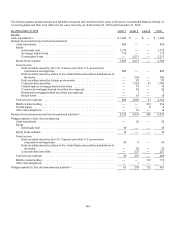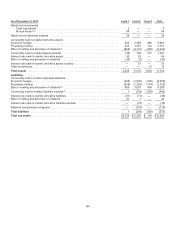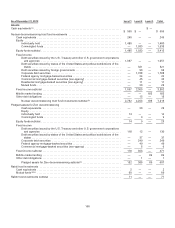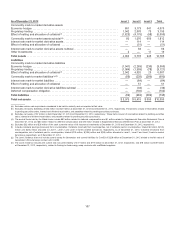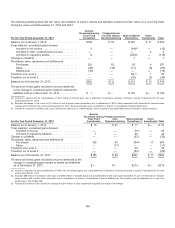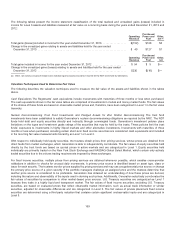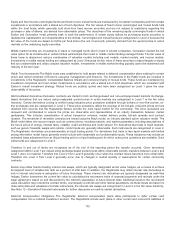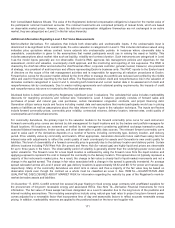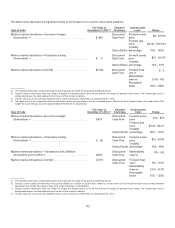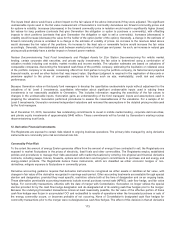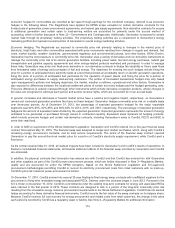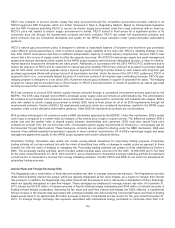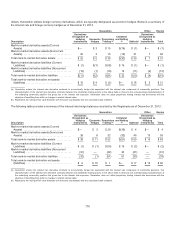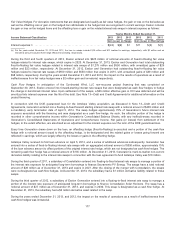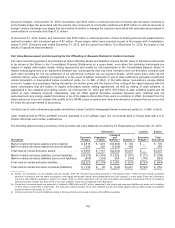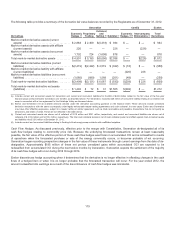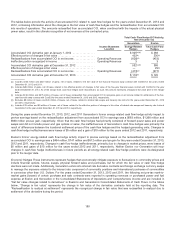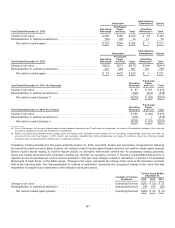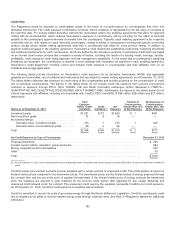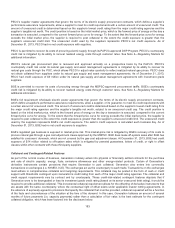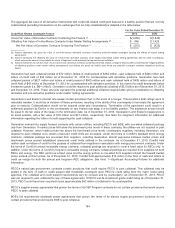ComEd 2013 Annual Report Download - page 180
Download and view the complete annual report
Please find page 180 of the 2013 ComEd annual report below. You can navigate through the pages in the report by either clicking on the pages listed below, or by using the keyword search tool below to find specific information within the annual report.economic hedgesfor commoditiesare recordedat fairvalue through earnings for thecombinedcompany, referredto aseconomic
hedgesinthefollowingtables. TheRegistrantshave appliedtheNPNS scope exception to certainderivativecontractsfor the
forwardsale ofgeneration,power procurement agreements, andnatural gassupplyagreements. Non-derivativecontractsfor access
to additional generation andcertainsalesto load-servingentitiesare accountedfor primarilyunder theaccrual methodof
accounting, which is further discussedinNote 22—CommitmentsandContingencies. Additionally, Generation is exposedto certain
market risks through itsproprietarytradingactivities. The proprietarytradingactivitiesare a complement to Generation’s energy
marketingportfoliobut represent a small portion ofGeneration’s overall energy marketingactivities.
Economic Hedging. TheRegistrantsare exposedto commoditypricerisk primarilyrelatingto changesinthemarket priceof
electricity, fossilfuels, andother commoditiesassociatedwithpricemovementsresultingfromchangesinsupplyanddemand, fuel
costs, market liquidity, weather conditions, governmental regulatoryandenvironmental policies, andother factors. WithinExelon,
Generation hasthemostexposure to commoditypricerisk. Generation usesavarietyofderivativeandnon-derivativeinstrumentsto
managethecommoditypricerisk ofitselectric generation facilities, includingpower sales, fuel andenergy purchases, natural gas
transportation andpipeline capacityagreementsandother energy-relatedproductsmarketedandpurchased. Inorder to manage
theserisks, Generation mayenter into fixed-pricederivative or non-derivativecontractsto hedgethevariabilityinfuture cash flows
fromforecastedsalesofenergy andpurchasesoffuel andenergy. Theobjectivesfor enteringinto such hedgesincludefixingthe
pricefor a portion ofanticipatedfuture electricitysalesat a level that providesan acceptable return on electric generation operations,
fixingthepriceofa portion ofanticipatedfuel purchasesfor the operation ofpower plants, and fixingthepricefor a portion of
anticipatedenergy purchasesto supplyload-servingcustomers. The portion offorecastedtransactionshedgedmayvarybased
upon management’s policiesandhedgingobjectives, themarket,weather conditions, operational andother factors. Generation is
alsoexposedto differencesbetween thelocational settlement pricesofcertaineconomic hedgesandthehedgedgeneratingunits.
This pricedifferenceis activelymanagedthrough other instruments which includederivativecongestion products, whosechangesin
fairvalue are recognizedin earnings each period, andauction revenue rights, which are accountedfor on an accrual basis.
Ingeneral,increasesanddecreasesinforwardmarket priceshaveapositiveandnegativeimpact,respectively, on Generation’s
ownedandcontractedgeneration positionsthat have not been hedged. Generation hedgescommoditypricerisk on a ratable basis
over three-year periods. AsofDecember 31,2013,the percentageofexpectedgeneration hedgedfor themajor reportable
segmentswas92%-95%, 62%-65% and30%-33%for 2014, 2015, and2016, respectively. The percentageofexpectedgeneration
hedgedistheamount ofequivalent sales dividedbytheexpectedgeneration.Expectedgeneration representstheamount ofenergy
estimatedto begeneratedor purchasedthrough ownedor contractedcapacity. Equivalent salesrepresent all hedgingproducts,
which includeeconomic hedgesandcertain non-derivativecontracts, includingGeneration’s salesto ComEd, PECO and BGE to
servetheir retail load.
Inorder to fulfill a requirement oftheIllinois Settlement Legislation,Generation andComEd enteredinto a five-year financial swap
contractthat expiredMay31,2013.Thefinancial swap wasdesignedto hedgespot market purchases, which, alongwithComEd’s
remainingenergy procurement contracts, met itsloadservicerequirements. The terms ofthefinancial swap contractrequired
Generation to paythe around-the-clock market pricefor a portion ofComEd’s electricitysupplyrequirement, while ComEd paid a
fixedprice.
AsthecontractexpiredMay31,2013,all realizedimpactshavebeen includedinGeneration’s andComEd’s resultsofoperations. In
Exelon’s consolidatedfinancial statements, all financial statement effectsofthefinancial swap recordedbyGeneration andComEd
are eliminated.
Inaddition,thephysical contractsthat Generation hasenteredinto withComEd andthat ComEd hasenteredinto withGeneration
andother suppliersaspart oftheComEd power procurement process, which are further discussedinNote 3—RegulatoryMatters,
qualify andare accountedfor under theNPNS exception.Basedon theIllinois Settlement Legislation and ICC-approved
procurement methodologiespermittingComEd to recover itselectricityprocurement costsfromretailcustomerswithno mark-up,
ComEd’s pricerisk relatedto power procurement is limited.
OnDecember 17, 2010,ComEd enteredinto several 20-year floating-to-fixedenergy swap contractswithunaffiliatedsuppliersfor the
procurement oflong-termrenewable energy andassociatedRECs. Deliveryunder thecontractsbegan inJune 2012.Pursuant to the
ICC’s Order on December 19, 2012,ComEd’s commitmentsunder theexistinglong-termcontractsfor energy andassociatedRECs
were reducedinthefirstquarter of2013.Thesecontractsare designedto lock in a portion ofthelong-termcommoditypricerisk
resultingfromthe renewable energy resourceprocurement requirementsintheIllinois Settlement Legislation.ComEd hasnot elected
hedgeaccountingfor thesederivativefinancial instruments. ComEd records thefairvalue oftheswap contractson itsbalancesheet.
BecauseComEd receivesfull costrecoveryfor energy procurement andrelatedcostsfromretailcustomers, thechangeinfairvalue
each periodisrecordedbyComEd asaregulatoryasset or liability. See Note 3—RegulatoryMattersfor additional information.
174


